Rodney Brooks - Roboticist
Books & Movies
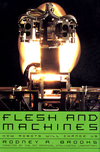
2002
Pantheon Books
order a copy from amazon.com

Flesh and Machines: How Robots Will Change Us
Flesh and Machines explores the startlingly reciprocal connection between humans and their technological brethren, and explains how this relationship is bring redefined as humans develop increasingly complex machines. The impetus to build machines that exhibit lifelike behaviors stretches back centuries, but for the last fifteen years much of this work has been done in Rodney Brooks' laboratory at MIT. His goal is not simply to build machines that are like humans but to alter our perception of the potential capabilities of robots. Our current attitude toward intelligent robots, he asserts, is simply a reflection of our own view of ourselves. In Flesh and Machines, Brooks challenges that view by suggesting that human nature can be seen to possess the essential characteristics of a machine. Our instinctive rejection of that idea, he believes, is itself a conditioned response: we have programmed ourselves to believe in our tribal specialness; as proof of our uniqueness. Provocative, persuasive, compelling, and unprecedented, Flesh and Machines presents a vision of our future and our future selves.
The body, this mass of biomolecules, is a machine that acts according to a set of specifiable rules... We are machines, as are our spouses, our children, and our dogs... I believe myself and my children all to be mere machines. But this is not how I treat them. I treat them in a very special way, and I interact with them on an entirely different level. They have my unconditional love, the furthest one might be able to get from rational analysis. Like a religious scientist, I maintain two sets of inconsistent beliefs and act on each of them in different circumstances. It is this transcendence between belief systems that I think will be what enables mankind to ultimately accept robots as emotional machines, and thereafter start to empathize with them and attribute free will, respect, and ultimately rights to them... When our robots improve enough, beyond their current limitations, and when we credit humans, then too we will break our mental barrier, our need, our desire, to retain tribal specialness, differentiating ourselves from them.

Arabic
Obeikan Publishers - order a copy from obeikanbookshop.com


British
Robot: The Future of Flesh & Machines
Penguin Books, Ltd. - order a copy from amazon.co.uk

Chinese
Eurasian Publising Group - order a copy from booklife.com.tw

Dutch
De Kunstmatige Mens: Hoe Machines Ons Veranderen
De Bexige Bij - order a copy from boekboek.nl


German
Menschmaschinen, Wie uns die Zukunftstechnologien neu erschaffen
Campus Verlag, GmbH - order a copy from amazon.de
Italian
Arnoldo Mondadori, Editore

Japanese
Flesh and Machines
Ohmsa Ltd - order a copy from amazon.co.jp

Korean
Flesh and Machines
Bada Publishing Co.

Spanish
Cuerpos Y Maquinas: De Los Robots Humanos a Los Hombres Robot
Ediciones B - order a copy from casadellibro.com

Robotics Research: Results of the 12th International Symposium ISRR
Edited by Sebastian Thrun, Rodney Brooks and Hugh Durrant-Whyte
2007, Springer Tracts in Advanced Robotics, Vol. 28 - order a copy from springer.com
The International Symposium of Robotics Research (ISRR) continues to be the premiere meeting of the International Foundation of Robotics Research (IFRR). The 12th International Symposium of Robotics Research took place October 12-15, 2005, in San Francisco, near Fisherman's Wharf, and was organized by the three editors of this book.
This volume contains a collection of 50 contributed papers, which were presented at the 12th International Symposium of Robotics Research. These papers are organized in twelve scientific tracks: Physical Human-Robot Interaction and Haptics, Planning, Humanoids, Mechanisms and Design, Simultaneous Localization and Mapping, Field Robots, Robotic Vision, Robot Design and Control, Underwater Robotics, Learning and Adaptive Behavior, Networked Robotics, and Interfaces and Interaction. Further articles in this volume summarize one of the invited overview talks of the scientific panel that took place during the ISRR.
Historically, the proceedings of the ISRR have featured ground-breaking work of the highest caliber, which influenced generations to come. The present volume promises to be no exception. The collection of scientific articles in this volume provides new insights to important problems in robotics, written by some of the leaders in the field.
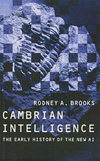
Cambrian Intelligence: The Early History of the New AI
1999, MIT Press (a Bradford Book) - order a copy from amazon.com
Until the mid-1980's, AI researchers assumed that an intelligent system doing high-level reasoning was necessary for the coupling of perception and action. In this traditional model, cognition mediates between perception and plans of action. Realizing that this core AI, as it was known, was illusory, Rodney A. Brooks turned the field of AI on its head by introducing the behavior-based approach to robotics. The cornerstone of behavior-based robotics is the realization that the coupling of perception and action gives rise to all the power of intelligence and that cognition is only in the eye of an observer. Behavior-based robotics has been the basis of successful applications in entertainment, service industries, agriculture, mining, and the home. It has given rise to both autonomous mobile robots and more recent humanoid robots such as Brooks's Cog. This book represents Brooks's initial formulation of and contributions to the development of the behavior-based approach to robotics. It presents all of the key philosophical and technical ideas that put this bottom-up approach at the forefront of current research in not only AI but all of cognitive science.
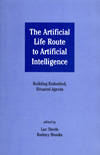
The Artificial Life Route to Artificial Intelligence: Building Embodied Situated Agents
Edited by Luc Steels and Rodney Brooks
1995, Lawrence Erlbaum Associates, Inc. - order a copy from amazon.com

Artificial Life IV: Proceedings of the Fourth International Worksop on the Synthesis and Simulation of Living Systems
Edited by Rodney Brooks and Pattie Maes
1994, MIT Press - order a copy from amazon.com
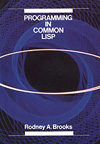
Programming in Common LISP
1985, John Wiley and Sons - order a copy from amazon.com

German
LISP: Programmieren in Common Lisp
R. Oldenbbourg Verlag - order a copy from amazon.de

Japanese
Programming in Common Lisp
John Wiley & Sons - order a copy from amazon.co.jp
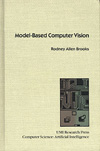
Model-Based Computer Vision
1984, UMI Research Press - order a copy from amazon.com
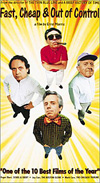
Fast, Cheap & Out of Control
A film by Errol Morris
1996, Sony Pictures Classics - order a copy from amazon.com
Acclaimed filmaker Errol Morris (The Thin Blue Line, A Brief History of Time) paints a fascinating portrait of four obsessed eccentrics in Fast, Cheap & Out of Control. Morris weaves interviews with a wild animal trainer, a topiary gardener, a robot designer and an expert on the naked mole rat together with old movies, cartoons and stock footage for a compelling, kaleidescope look at the very thin line which separates madness from genius.
 Copyright 2008-2018
Copyright 2008-2018 ![]() last updated January 2018
last updated January 2018 